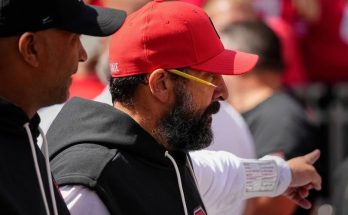The Brave Move of the Bears: The Steelers Reject the Mike Tomlin Trade Investigation
In a bold and controversial move that has captivated the NFL world, the Chicago Bears recently made an audacious proposal to acquire Pittsburgh Steelers head coach Mike Tomlin. Reports suggest the Bears were willing to trade significant draft capital and assets in a bid to lure the veteran coach away from the Steel City. However, the Steelers swiftly rejected any consideration of a deal, standing firm on their commitment to Tomlin. The episode has sparked debates across the league about the value of a head coach, the ethics of such moves, and the future trajectories of both teams.
Background: Why Mike Tomlin?
Mike Tomlin’s tenure with the Pittsburgh Steelers is nothing short of extraordinary. Since being hired in 2007, Tomlin has cemented himself as one of the NFL’s most consistent and respected head coaches. Under his leadership, the Steelers have not endured a single losing season—a feat that underscores his ability to adapt and succeed regardless of the challenges presented.
Tomlin’s resume includes two AFC championships, a Super Bowl title, and a reputation for fostering a culture of accountability and excellence. His teams are known for their physicality, discipline, and resilience—qualities that any franchise would covet. It’s no wonder the Bears, a team in desperate need of a cultural and strategic overhaul, saw Tomlin as the perfect candidate to lead their resurgence.
The Bears’ Desperation
The Chicago Bears have been mired in mediocrity for years, plagued by inconsistent quarterback play, underwhelming draft choices, and a revolving door of head coaches. Despite being one of the league’s oldest and most storied franchises, the Bears have struggled to regain the dominance they enjoyed in the mid-1980s.
Entering the 2024 offseason, the Bears faced mounting pressure from their fanbase and ownership to make a transformative move. The franchise has young talent, including quarterback Justin Fields, but development has been stunted by organizational instability. By targeting Tomlin, the Bears signaled their willingness to think outside the box and prioritize long-term success over short-term expediency.
The Steelers’ Perspective
From Pittsburgh’s standpoint, the idea of trading Mike Tomlin was never an option. The Steelers are a franchise built on continuity and loyalty, values that have been central to their identity for decades. Tomlin is only the third head coach the team has employed since 1969, following in the footsteps of legends Chuck Noll and Bill Cowher. This stability has been a cornerstone of the Steelers’ success, and trading Tomlin would represent a seismic departure from tradition.
Moreover, Tomlin remains deeply embedded in the Steelers’ culture and vision. Even during seasons of roster transitions and injuries, he has managed to keep the team competitive. Letting him go would not only disrupt the organization but also risk alienating a fanbase that holds him in high regard.
The Ethics of Trading a Coach
The concept of trading head coaches is rare in the NFL but not unprecedented. High-profile examples include Jon Gruden, who was traded from the Oakland Raiders to the Tampa Bay Buccaneers in 2002, and Bill Belichick, who was involved in a trade from the New York Jets to the New England Patriots in 2000. These trades, however, are anomalies rather than the norm, and they raise ethical questions about the commodification of coaching talent.
For the Bears, the decision to pursue Tomlin was a calculated gamble. By dangling lucrative trade assets, they hoped to test the Steelers’ resolve and potentially secure a proven leader. However, critics argue that such moves undermine the sanctity of coaching contracts and create a slippery slope where franchises can poach successful coaches with little regard for the impact on their current teams.
For the Steelers, rejecting the overture was as much about principle as it was about strategy. Allowing Tomlin to leave—even for a king’s ransom of draft picks—would set a dangerous precedent. It would signal to the league that no coach is untouchable, potentially destabilizing the broader coaching ecosystem.
Implications for the Bears
The Bears’ failed bid for Tomlin underscores the franchise’s desperation but also its ambition. By targeting one of the league’s most accomplished coaches, Chicago demonstrated a willingness to go all-in on building a winning culture. The move may have been unsuccessful, but it sends a message to players, fans, and potential coaching candidates that the Bears are serious about change.
However, the rejection leaves the Bears at a crossroads. Without Tomlin, they must pivot to Plan B—whether that involves promoting from within, hiring a promising coordinator, or pursuing another established head coach. Each option carries risks, and the pressure to make the right decision is immense.
Implications for the Steelers
For Pittsburgh, the incident reaffirms their organizational philosophy. By rebuffing the Bears’ offer, the Steelers reinforced their commitment to stability and loyalty. It also serves as a vote of confidence in Tomlin, signaling that the franchise believes he remains the right person to lead them into the future.
The Steelers’ decision could also have ripple effects throughout the league. By refusing to entertain the trade, Pittsburgh may deter other teams from attempting similar moves in the future. It’s a stance that protects the integrity of coaching contracts and upholds the principle that some assets are simply not for sale.
The Broader NFL Landscape
The saga of the Bears’ pursuit of Mike Tomlin is emblematic of larger trends in the NFL. As the league becomes increasingly competitive, the value of strong leadership has never been higher. Teams are willing to invest heavily in top-tier coaches, recognizing that a great leader can be the difference between sustained success and perennial disappointment.
At the same time, the incident highlights the challenges faced by struggling franchises. For teams like the Bears, the path to relevance often involves bold and unconventional moves. While the pursuit of Tomlin ultimately fell short, it underscores the lengths to which teams will go to secure an edge in a highly competitive environment.
Lessons Learned
For the Bears, the key takeaway is the importance of patience and strategic planning. While the allure of a quick fix is tempting, true success requires a strong foundation and a commitment to long-term goals. Chicago must now focus on identifying a leader who can instill the discipline, culture, and vision necessary to turn the franchise around.
For the Steelers, the episode is a reminder of the value of stability and trust. By standing by Tomlin, Pittsburgh reaffirmed its belief in the power of consistency and loyalty. It’s a philosophy that has served the franchise well for decades and one that continues to set them apart in an ever-changing league.



